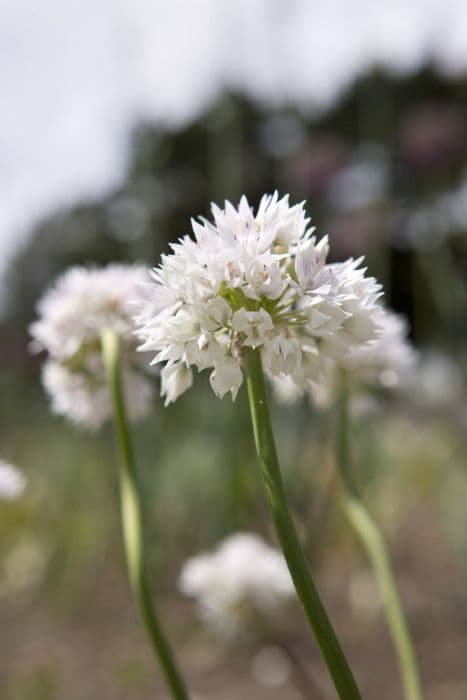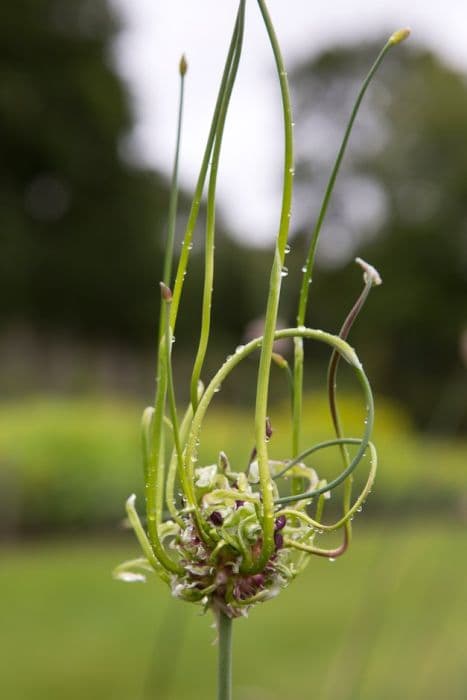Ornamental Onion Allium 'Mercurius' (PBR)

ABOUT
Allium 'Mercurius', more commonly known as Ornamental Onion, boasts a distinctive appearance characterized by its globular flower heads that burst with tightly clustered star-shaped blossoms. These blooms are a stunning violet-purple hue that add a rich and exuberant splash of color to any garden. The flowers are perched atop sturdy, upright stems that gracefully rise above strappy, green, basal leaves. The leaves of the Ornamental Onion have a linear shape with a smooth texture, creating a lush, grounding visual at the base of the plant. These leaves typically die back before the blooms emerge. The globes of the Ornamental Onion's flowers create a visual spectacle, making it a favorite among gardeners looking for bold, eye-catching elements in their landscaping design. The plant's whole aesthetic is one of drama and elegance, which, coupled with its colorful allure, makes it a highlight in any setting where it is planted.
About this plant
 Names
NamesFamily
Amaryllidaceae
Synonyms
Mercurius Allium, Ornamental Onion
Common names
Allium 'Mercurius' (PBR)
 Toxicity
ToxicityTo humans
The plant in question is a cultivar of Allium, commonly known as ornamental onion. Typically, Allium species are not highly toxic to humans. Many Alliums, like onions and garlic, are commonly used in cooking and are safe when used in normal culinary quantities. Overconsumption of Alliums can lead to gastrointestinal upset, but in the case of ornamental varieties like 'Mercurius', it is not recommended to ingest any part of the plant as they are not cultivated for consumption. The ornamental varieties have not been thoroughly studied for toxicity in humans, so it is best to err on the side of caution and avoid ingestion. If ingested in large quantities, they could potentially cause symptoms similar to those caused by other non-edible Alliums, which may include nausea, vomiting, and diarrhea.
To pets
Allium 'Mercurius', which is an ornamental onion, is toxic to pets, especially cats and dogs. Allium species contain compounds that can be harmful to pets if ingested. Eating this plant can lead to symptoms such as gastrointestinal upset, drooling, nausea, oral irritation, vomiting, and diarrhea. In more severe cases, ingestion can lead to lethargy, abdominal pain, elevated heart and respiratory rates, weakness, and exercise intolerance. In pets, particularly dogs and cats, eating large amounts of Allium can cause oxidative damage to red blood cells leading to hemolytic anemia, which is a serious condition characterized by the destruction of red blood cells. If you suspect your pet has ingested this plant, immediate veterinary attention is recommended.
 Characteristics
CharacteristicsLife cycle
Perennials
Foliage type
Deciduous
Color of leaves
Varies
Flower color
Varies
Height
2 feet (60 cm)
Spread
1 feet (30 cm)
Plant type
Bulb
Hardiness zones
5
Native area
Asia
Benefits
 General Benefits
General Benefits- Ornamental Appeal: Offers an aesthetically pleasing display with its beautiful, spherical purple flowers.
- Low Maintenance: Requires minimal care once established, making it suitable for gardeners of all skill levels.
- Drought Tolerance: Able to withstand periods of low water availability.
- Pest Resistance: Naturally resistant to many pests, minimizing the need for chemical treatments.
- Attracts Pollinators: Draws bees, butterflies, and other beneficial pollinators to the garden, fostering a healthy ecosystem.
- Long Blooming: Has a lengthy flowering period which provides prolonged visual interest in the garden.
- Culinary Use: The edible parts can be used in cooking for their onion-like flavor.
- Easy to Grow: Can be successfully grown in a variety of soil types and climatic conditions.
 Medical Properties
Medical PropertiesThis plant is not used for medical purposes.
 Air-purifying Qualities
Air-purifying QualitiesThis plant is not specifically known for air purifying qualities.
 Other Uses
Other Uses- Allium 'Mercurius' can be used in dried flower arrangements for long-lasting displays, as the spherical flower heads maintain their shape and color after drying.
- The sturdy stems of Allium 'Mercurius' make it suitable for crafting botanical jewelry such as rings or pendants, particularly when the flowers are dried.
- With its tall, striking blooms, Allium 'Mercurius' can serve as a natural pest deterrent in gardens, as the strong scent is known to repel certain insects and animals.
- These ornamental onions can be used in a biodegradable garden markers system, utilizing the dried flower stalks to label rows of plants.
- The seeds of Allium 'Mercurius' can be bundled and used as a natural bird feeder, attracting wildlife to gardens.
- The distinctive spherical shape of the flowers allows for their use in geometric garden designs, adding a structural element to landscaping.
- Allium 'Mercurius' can also be incorporated into nature-inspired art installations, either in its natural form or as a cast mold for sculptures.
- As a photography subject, Allium 'Mercurius' offers an interesting texture and form for macro photography enthusiasts.
- The plant can be used in educational settings to teach students about plant growth, pollination, and the lifecycle of flowering plants.
- Culinary presentation can also benefit from the unique look of Allium 'Mercurius', with chefs using the flower heads as an edible decoration for upscale dishes, assuming the variety is non-toxic and grown organically.
Interesting Facts
 Feng Shui
Feng ShuiThe Allium, commonly known as ornamental onion, is not used in Feng Shui practice.
 Zodiac Sign Compitability
Zodiac Sign CompitabilityThe ornamental onion is not used in astrology practice.
 Plant Symbolism
Plant Symbolism- Perseverance and Strength: Alliums are known for their hardiness and ability to thrive in challenging conditions. 'Mercurius' as a cultivar represents the qualities of resilience and persistence.
- Unity and Togetherness: The globe-shaped flower heads of the Allium signify coming together, with the many small flowers representing a well-structured unit.
- Good Fortune: In some cultures, Alliums are thought to bring luck and are often planted to ward off evil and attract positivity into a space.
- Protection: Historically, Alliums have been used for their antibacterial properties. Symbolically, they serve as a plant emblem for protection against illness and misfortune.
- Pride: Their upright stems and eye-catching blooms often stand above other garden plants, making them a symbol of pride and self-confidence.
 Water
WaterOrnamental onions, like the Allium 'Mercurius', require regular watering to establish deep roots, especially during their growing season in spring and early summer. The soil should be kept evenly moist but not waterlogged. Water them with approximately 1 inch of water per week, which equates to about 0.6 gallons for each square foot of soil. During hot, dry spells, you may need to increase the frequency to twice a week, ensuring that the water penetrates deeply into the soil. Always check the soil moisture before watering; if the top inch feels dry, it's time to water. Reduce watering after the flowers have faded and the leaves begin to yellow, signaling their dormant period.
 Light
LightOrnamental onions thrive best in full sun conditions, where they receive at least 6 to 8 hours of direct sunlight per day. Plant the Allium 'Mercurius' in a spot that is exposed to the sun throughout the day to ensure vigorous growth and optimal flowering. These plants can tolerate partial shade but may not bloom as profusely if they do not get enough light.
 Temperature
TemperatureThe ideal temperature range for the ornamental onion is between 55°F and 75°F. They can withstand a minimum temperature down to about 20°F, making them suitable for many temperate climates. Allium 'Mercurius' prefers cooler conditions during their dormant period in the fall and can survive winter cold well. However, they should be protected from extreme heat, with temperatures above 90°F potentially causing stress to the plants.
 Pruning
PruningPruning ornamental onions is essential to prevent self-seeding and to keep the garden tidy. Allium 'Mercurius' should be deadheaded after the flowers have faded and before the seeds develop. If you want to avoid self-sowing, remove the flower heads. Generally, pruning is not necessary until the blooms are spent; this usually occurs by mid-summer. Leave the foliage in place until it has yellowed and withered; it will continue to photosynthesize and strengthen the bulb for the next season.
 Cleaning
CleaningAs needed
 Soil
SoilOrnamental Onion 'Mercurius' thrives in well-draining soil that is rich in organic matter, with a preferred pH range between 5.5 and 6.5. A good soil mix for this plant can be composed of equal parts loamy garden soil, compost, and sharp sand, ensuring good drainage and fertility.
 Repotting
RepottingOrnamental Onions like 'Mercurius' generally do not need frequent repotting. They should be repotted once they become root-bound or every 3-4 years to replenish soil nutrients. Ensure adequate space for bulb growth when repotting.
 Humidity & Misting
Humidity & MistingOrnamental Onion 'Mercurius' is not overly sensitive to humidity levels and does well in average room humidity. Aim to maintain humidity levels between 40-60% for optimal growth, avoiding excessively dry air which can cause stress.
 Suitable locations
Suitable locationsIndoor
Place in a bright spot and water sparingly.
Outdoor
Full sun, fertile soil, water as needed, spaced 6 inches.
Hardiness zone
5-9 USDA
 Life cycle
Life cycleAllium 'Mercurius', commonly known as ornamental onion, starts its life cycle as a dormant bulb, which germinates in the spring when soil temperatures rise. The plant then produces strap-shaped green leaves and a tall stem, culminating in a spherical bloom comprised of numerous star-shaped purple flowers, typically in late spring to early summer. After flowering, the plant sets seed, and the foliage begins to die back as the plant enters a phase of dormancy during the hot summer months. The seeds can then disperse, potentially giving rise to new plants, while the original bulb remains dormant underground. As temperatures cool in autumn, the bulb may begin to produce new roots in preparation for the next cycle. In some cases, the plant may also propagate asexually through bulb division, where small bulblets form around the main bulb and can be separated and planted to grow new individual plants.
 Propogation
PropogationPropogation time
Spring-Early Summer
Propogation: Allium 'Mercurius', commonly known as ornamental onion, is generally propagated through division, which is ideally done when the plant is dormant, typically in either spring or fall. The most popular method involves carefully digging up the clumps of bulbs when they have become overcrowded, usually after several years of growth. Using a spade or fork, gardeners should gently separate the bulbs, being careful not to damage them. Once separated, the bulbs can be immediately replanted at the same depth they were originally growing, typically about 3 to 4 inches deep (7.6 to 10.16 cm deep), in well-drained soil with appropriate sun exposure. It's important to space the bulbs about 8 to 10 inches apart (20.32 to 25.4 cm apart) to ensure enough room for growth. This straightforward division technique allows ornamental onion bulbs to rejuvenate and continue producing vibrant blooms in the following seasons.








